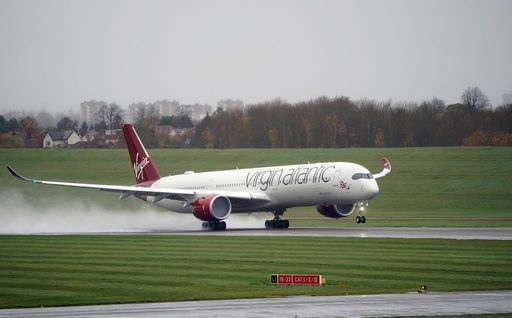Two decades ago, motorists in South Wales realised that they could power their diesel cars with used cooking oil, thereby cutting their fuel bills substantially. They were fined for trying to avoid road fuel duty, but perhaps they should have been bunged £1 million by the government for demonstrating a greener future.
£1 million is the sum the government handed Virgin to enable today’s pioneering transatlantic flight using 100 per cent sustainable airline fuel (SAF). SAF is a blend of 88 per cent hydroprocessed esters and fatty acids (HEFA), manufactured from waste cooking oil, and 12 per cent synthetic aromatic kerosene, made from plant sugars from waste vegetable material.
Running a jet on low-carbon fuels would only reduce its total ‘climate impact’ by between 30 and 60 per cent
The attraction of SAF for airlines is obvious. As today’s flight will demonstrate, it is a ‘drop-in’ fuel which can be used in existing aircraft. Other suggested ways in which aviation might be decarbonised have serious problems of practicality. Try to stuff a Boeing 777 with enough batteries to supply the power needed to cross the Atlantic and the plane would become as heavy as the Eiffel Tower – it wouldn’t get off the ground at all. It would require a couple of magnitudes of improvements in battery technology to make long-haul electric jets a possibility. Hydrogen, by contrast, has a high energy-to-mass ratio but a low energy-to-density ratio, meaning that it would require a wholesale redesign of planes, which would become bulkier, slower and generally less useful.
SAF will do the job – albeit at a current cost of around four times that of normal jet fuel. However, it is also something of a dead end, as there are only so many chip shops producing so much waste oil. Using waste plant material to generate energy makes sense from a waste disposal perspective, but how much is actually potentially available?
Look beyond waste cooking oil, claims the US Bioenergy Technologies Office, and the US could, just about, power its current fleet of jets entirely with SAF – if it could harness every last twig and leaf of available biomass. It calculates that if you could collect all waste food from households and businesses, forestry residues, solids from sewage plants, algae from rivers and lakes, agricultural waste and add it to some dedicated biomass crops it would be enough to produce between 50 and 60 billion gallons of fuel. In 2021 alone, US airlines between them used 57 billion gallons of fuel.
All of this would involve a hugely dispersed supply chain which would have to be brought together. Moreover, woody biomass does not exactly come in as convenient a form for conversion into liquid fuels as used cooking oil – so the costs are going to be substantially greater.
There is another potential – and possibly even more expensive – solution involving making synthetic fuels from hydrogen and carbon. Hydrogen is extracted via electrolysis of water and carbon extracted from carbon dioxide in the air. But that is a technology which is some way into the future, given the problems encountered in scaling up the production of hydrogen via electrolysis.
But would sustainable and synthetic airline fuels allow the airline industry to reach net zero in any case? There’s the rub. Neither solution avoids water vapour emissions via the con-trails spewed out of the back of jet engines, which contribute a substantial proportion of a jet aircraft’s greenhouse gas emissions. According to a study by McKinsey&Co in 2020, running a jet on low-carbon fuels would only reduce its total ‘climate impact’ by between 30 and 60 per cent.
That might be a useful contribution, but it gets the airline industry nowhere near the holy grail of net zero. Trouble is, this is the target we have legally committed ourselves too, and we still have no idea of how industries like aviation can get there.







Comments